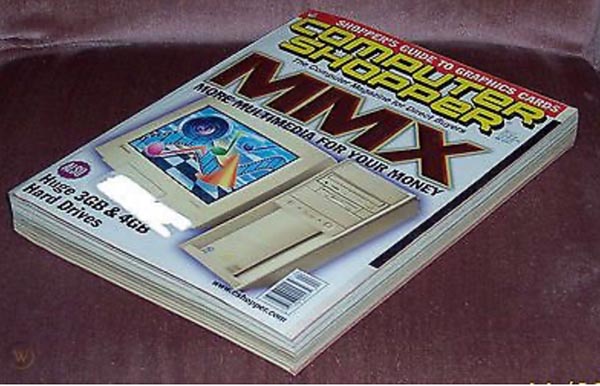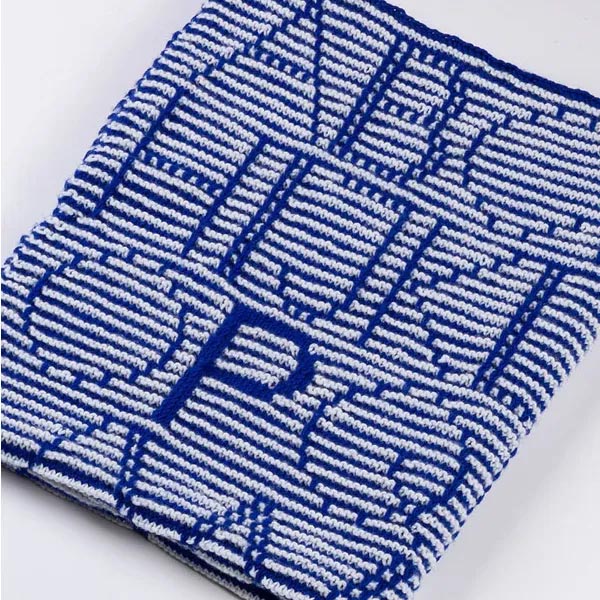Around the Web: Perishing Publishing. Garment Graphics. Edo Education. Tagging Tech. Canine Companion. Film Fest. Glorious Gate. Cosmic Consolidation. Colossal Candy. Soothing Signage.
The final two laptop magazines cease publishing. A typeface designed for knitting. A brand new bioink for 3D organ printing. Library of Congress hosts a workshop on uncommon Japanese books. A robotic designed to color graffiti, for some purpose. An AI-based robotic dogsitter. A graphene-based cardiac pacemaker. 16-millimeter fil turns 100 years previous. The world’s biggest gate. The James Webb House Telescope captures two galaxies merging. Russell Stover’s 5,000-pound field of candies. The therapeutic impact of power-washing avenue indicators. All that and extra in WhatTheyThink’s weekly miscellany.
The Final Two Laptop Magazines Byte the Mud
What number of of you keep in mind Byte journal? PC World? Or, throughout the aisle, Macworld? The venerable Laptop Shopper? The Seventies, 80s, and 90s noticed the Golden Age of the printed laptop journal. Not solely had been there a slew of titles, however they had been all huge publications. (Bear in mind when magazines had been good sure?) Subscriptions had been sturdy, newsstand gross sales (keep in mind them?) had been massive, and ad gross sales had been plentiful. Most significantly, all this success funded quite a lot of actually good tech journalism.

Bear in mind this?
As everyone knows, the period of the print laptop journal is now over, and with the latest demise of Most PC and MacLife, the final two printed laptop magazines have shuffled off this mortal coil. Former PC World editor Harry McCracken appears to be like again at these halcyon days of laptop publishing:
I take the loss personally, and never simply because laptop magazines saved me gainfully employed from 1991-2008. As a junior excessive scholar and Radio Shack TRS-80 fanatic, I purchased my first laptop journal in late 1978, three years after Byte invented the class. It was an necessary sufficient second in my life that I can let you know what it was (the November-December 1978 concern of Inventive Computing) and the place I bought it (Harvard Sq.’s Out of City Information, the identical newsstand that had performed a crucial position within the founding of Microsoft simply 4 years earlier). Even earlier than I bought that Inventive Computing, our mailman had misdelivered a neighbor’s copy of Byte to our home, an error I welcomed and didn’t try and appropriate. From the second I found laptop magazines, I cherished them nearly as a lot as I cherished computer systems, which is why I ended up working within the subject for therefore lengthy.
I spent most of that point at PC World, which I joined in late 1994 at nearly exactly the second it launched its first internet presence. From the beginning, the net was a terrific option to preserve tabs on tech information. Ultimately, it will make the entire concept of a publication about computer systems that got here out as soon as a month really feel greater than somewhat foolish. It additionally let retailers attain clients straight, a gut-punch to the ad enterprise that had made PC World and its greatest rivals so worthwhile.
However the internet didn’t render printed laptop magazines out of date in a single day. PCW had a few of its fattest, happiest years as a enterprise within the late Nineteen Nineties. Even in 2008, once I left, the print journal was a revenue heart, not an albatross.
However all of us knew that the writing was on the wall, and it appears weirdly ironic for expertise publishing to have been achieved in by expertise. But it surely’s the identical story as all of us in publishing wrestle with: find out how to develop a enterprise mannequin for on-line publishing when all the things is anticipated to be free (and other people like to complain about paywalls).
Ought to we mourn the top of laptop publications printed on paper? No—and sure. What was nice in regards to the laptop journal age wasn’t that the data was printed on lifeless bushes and delivered by truck as soon as a month. In most respects that matter, the net is a far superior option to preserve individuals knowledgeable in regards to the expertise of their lives.
However as well timed and environment friendly a way of communication as on-line media is, your entire laptop publishing business failed to determine find out how to flip it right into a enterprise that was remotely as vibrant as print had been. And people huge portions of full-page adverts paid for some amazingly formidable service journalism.
And even tech writers have needed to adapt to new methods of doing issues.
There may be nonetheless high-quality work being achieved on the on-line incarnations of former print publications and newer retailers that had been digital from the beginning. I haven’t even talked about the truth that at the moment’s tech media spans the written phrase, video, audio, and group—and that it’s potential for a person journalist to partake in the entire above with out being employed by an enormous firm. Backside line: If there was a magic change that might allow us to ditch present-day laptop journalism for what we had in, say, 1995, I wouldn’t flip it.
In fact, our personal business is not any stranger to the slings and arrows of publishing expertise. Have a look at what number of printing business publications existed all through the twentieth century in comparison with what number of exist now. All of us in publishing are in just about the identical boat—and how different markets of fared will help us maybe steer that boat collectively.
Grotesque Sweaters
Graphic arts consultants know that the phrase “grotesque” means one thing completely different on this planet of typography than it does to laypeople, however now a brand new typeface designed for knitting can embody each meanings. Says Print journal:
Rüdiger Schlömer pushes the bounds of what’s potential within the kind world with Knit Grotesk: a typeface meant for knitting. This pixelated font works each onscreen and on material, and it’s preferrred for shiny shade combos and attention-grabbing textures. Plus, Knit Grotesk is predicated on the easy construction of Futura, including a excessive legibility to this versatile typeface.
It’s not usually we discover typefaces that work within the tangible world, so the chances are magnificent. I’m imagining this on a yellow sweater with a neon pink secondary hue, spelling out one thing as fantastically sudden as “bumfuzzle.”

KNIT GROTESK first letters had been impressed by a low-res adaptation of Futura (FuturX by Laucke Siebein), whereas translating it right into a hand knitting sample. By this formatting course of originated a complete set of typographic particulars which advanced right into a typeface of its personal. Probably the most attribute aspect – the vertical line grid – derives from the alternating two tone double rows used slipstitch knitting.
Inking System
WhatTheyThink contributor Mark V (inheritor to the throne of Mark IV) factors us to a brand new bioink that solves among the issues inherent in 3D-printed organs and tissues. Says ScienceBlog:
generally used hydrogel-based bioinks may cause cytotoxicity because of the chemical crosslinking agent and ultraviolet gentle that join the molecular construction of photocuring 3D-printed bioink.
Nevertheless, Dr. Track Soo-chang’s and his analysis staff on the Korea Institute of Science and Know-how’s Middle for Biomaterials has developed a “poly(organophosphazene) hydrogel-based temperature-sensitive bioink that stably maintained its bodily construction solely by temperature management with out photocuring, induced tissue regeneration, after which biodegraded within the physique after a sure time period.”
Present hydrogel-based bioinks should undergo a photocuring course of to reinforce the mechanical properties of the 3D scaffold after printing, with a excessive threat of opposed results within the human physique. As well as, there have been chance of negative effects by transplanting externally cultured cells inside bioink to extend the tissue regeneration impact. Accordingly, the analysis staff developed a brand new bioink materials utilizing a temperature-sensitive poly(organophosphazene) hydrogel, which existed in a liquid type at low temperatures and adjusted to a tough gel at physique temperature. This enabled the regeneration of tissues solely by temperature management with out chemical crosslinking brokers or UV irradiation and the manufacture of a three-dimensional scaffold with a bodily secure construction, minimizing the potential for immune opposed results within the human physique.
The brand new bioink to this point has solely been used to regenerate bone tissues, however the purpose is to permit it for use within the regeneration of different kinds of tissues and organs.
Discovering Japan
Are you curious about Japanese uncommon books? Will you be in Washington, DC, in August? If sure to each, excellent news! Whereas August will not be a really perfect time to be in Washington when you occur to have sweat glands, the Affiliation for Asian Research is internet hosting a three-day Japanese uncommon ebook workshop in August 9–11 on the Asian Division, Library of Congress. The purpose of the workshop is for attendees to realize superior bibliographic information of the books printed in Japan’s Edo interval. This workshop is funded by the Toshiba Worldwide Basis (TIFO) with assist supplied by the Library of Congress and the Library of the Nationwide Museum of Asian Artwork. Says Humanities and Social Sciences On-line:
The Teacher, Professor Takahiro”Sasa’I of Kei? College Shid? Bunko, will give a two-day lecture on the Edo hanpon, together with definitions of specialised phrases, sources of printing data, willpower of printing date, and different points of printing tradition within the Edo interval (1603-1867). Throughout his lecture, Professor Sasaki will focus on among the books from LC’s huge assortment of Japanese uncommon holdings. A tour to LC’s Asian Studying Room and Primary Studying Room and the Pulverer Assortment and the Library of the Nationwide Museum of Asian Artwork can be held on the third day. The Subcommittee on Japanese Uncommon Books beforehand provided a one-day normal workshop on Japanese uncommon books on the Artwork Institute of Chicago in 2015 and a three-day specialised workshop on the Edo printed books on the Library of the Freer Gallery of Artwork and Arthur M. Sackler Gallery, Smithsonian Establishment in 2018, each with Prof. Takahiro Sasaki as the trainer. The 2023 workshop can be a sequel to these, and the people who’ve accomplished both workshop or related coaching, and/or these with rapid wants of dealing with Edo printed books for his or her work or analysis can be prioritized for choice of members.
FYI, all lectures can be given in Japanese, though excursions can be given in English. Registration ($30) is required and attendance is proscribed to twenty. In the event you’re , register right here.
Bodily Graffiti
Simply what we would have liked: a robotic that paints graffiti. Graduate college students at Georgia Tech have constructed the primary graffiti-painting robotic system. Known as GTGraffiti, it “makes use of movement seize expertise to report human portray motions after which composes and processes the gestures to program a cable-driven robotic that spray paints graffiti paintings.” Says Georgia Tech:
A number of the most common industries for robotics purposes embrace manufacturing, biomedicine, vehicles, agriculture, and the army. However the arts, it seems, can showcase robotics in an particularly highly effective manner.
“The humanities, particularly portray or dancing, exemplify among the most advanced and nuanced motions people could make,” Chen mentioned. “So if we wish to create robots that may do the extremely technical issues that people do, then creating robots that may dance or paint are nice targets to shoot for. These are the kinds of abilities that reveal the extraordinary capabilities of robots and may also be utilized to quite a lot of different purposes.”
On a private stage, Chen is motivated by his hope for individuals to understand robots as being useful to humanity, fairly than seeing them as job-stealers or entities that trigger emotions of concern, disappointment, or doom as usually depicted in movie.
AI-Yi-Yi, Half the Infinity: For the Canine
Through Axios, a brand new system from an organization referred to as Companion has been developed which is an AI-based dogsitter. (It’s known as a “nanny” and “tutor” which—sorry—will not be phrases that needs to be utilized to canines. And the time period “furbaby” is simply deeply mistaken.)
The stationary system — which dispenses treats — “gives all day scheduled and on-demand engagement on your canine with video games, behavioral applications and coaching,” the corporate says.
It concurrently displays your canine’s well being, in search of “sudden or delicate shifts in your canine’s motion or posture that may point out ache, nervousness or stress.”
All probably heightened by interacting with an AI-based robotic.
The system makes use of “AI {hardware}, machine studying and best-in-class optimistic reinforcement strategies,” Companion says.
As an example, by enjoying instructions like “sit” utilizing an proprietor’s voice, the Companion teaches the canine obedience — whereas noticing any bodily adjustments that may sign illness. (See a video right here — scroll all the way down to “mission and imaginative and prescient.”)
And one of many oddest strains we have now ever quoted on AtW (which is saying one thing):
“It’s nearly like beginning a chatbot along with your canine.”
Taking Graphene to Coronary heart
Was it a very good week for graphene information? It’s at all times a very good week for graphene information! Researchers at Northwestern College and the College of Texas at Austin (UT) have developed a graphene-based cardiac implant. From (who else?) Graphene-Data:
Comparable in look to a brief tattoo, the brand new graphene “tattoo” implant is thinner than a single strand of hair but nonetheless capabilities like a classical pacemaker. However in contrast to present pacemakers and implanted defibrillators, which require arduous, inflexible supplies which are mechanically incompatible with the physique, the brand new system softly melds to the guts to concurrently sense and deal with irregular heartbeats. The implant is skinny and versatile sufficient to adapt to the guts’s delicate contours in addition to stretchy and robust sufficient to face up to the dynamic motions of a beating coronary heart.
It is usually clear, which permits researchers to allow it to carry out optocardiography—utilizing gentle to watch and management coronary heart rhythm.
Whereas electrical stimulation can appropriate a coronary heart’s irregular rhythm, optical stimulation is extra exact. With gentle, researchers can monitor particular enzymes in addition to interrogate particular coronary heart, muscle or nerve cells.
Movie at 100
On Wednesday, we celebrated the centenary of the arrival of 16-millimeter movie. That’s, on April 18, 1923, Eastman Kodak launched a revolutionary new movement image digicam, that simply occurred to be primarily based on an equally revolutionary new movie format. Says the NY Occasions:
The corporate had been promoting filming gadgets for greater than 20 years by then, however this novel contraption — the Ciné-Kodak digicam, bought with the Kodascope projector — provided a brand new thrill: the flexibility to make and display screen films at dwelling, with no particular experience.
The technical marvel, nevertheless, wasn’t simply the digicam but additionally the movie inside. Till 1923, the movie used mostly in movement photos was 35 millimeters huge. That 12 months, Kodak produced a brand new format that was solely 16 millimeters. The picture wasn’t as sharp whenever you blew it up on the large display screen, nevertheless it allowed for smaller, cheaper and extra moveable cameras.
The brand new movie format opened up filmmaking not simply to these trying to shoot dwelling films, however to indie filmmakers who needed to make films outdoors the Hollywood system and journalists who may now seize dwell occasions.
Common people may now report their very own lives, journalists and troopers may movie within the midst of battle, and activists may shoot political documentaries on the street. Till digital video arrived within the late Nineteen Nineties, 16-millimeter movie was the mainstay of the novice or unbiased filmmaker, requiring neither the funding nor the know-how of economic cinema.
Occasions change, however not that a lot.
Right now, 16 millimeter is now not optimum for the novice filmmaker. Analog movie is more and more costly, fewer and fewer labs can course of it, and the format doesn’t enable the practically limitless taking pictures and on the spot playback that video does. However even because it turns 100, 16 millimeter nonetheless has a singular look that neither 35-millimeter movie nor video can rival.
In case you are aware of filmmaker Darren Aronofsky, he has used 16-millimeter movie by selection, corresponding to for “The Wrestler” (2008), “Black Swan” (2010), and “Mom!” (2017).
Pearly Gates
Do you want gates? And we don’t imply Invoice Gates, varied political -gates, and even Gates McFadden. We imply precise latching gates. Properly, if you’re a gate aficionado, we have now a gaggle for you. Sure there’s a Gate Appreciation Society, and it has nearly 120,000 members. And so they have recognized the “world’s biggest gate.” It’s hand-carved, with magnificent Celtic spirals etched into it and a hand-forged spring fastener latch that was designed to appear like a shepherd’s criminal. It leads into (or out of, relying which aspect you’re on) Ynys Llanddwyn, a small tidal island simply off the west coast of Anglesey, Wales. You’d be inclined to suppose it was an previous construction, nevertheless it’s really pretty new, having bene carved by Dafydd Davies-Hughes, a gatemaker whose work might be seen all through north Wales. In response to his web site, he as soon as made an oak balcony designed to appear like a human hand.

So what makes it the world’s biggest gate? Says The Guardian:
the Gate Appreciation Society [is] a Fb group with 118,000 members. The Ynys Llanddwyn gate has gone down so fantastically with the society {that a} picture of it has 42,000 likes.
… I’m afraid the Ynys Llanddwyn gate’s title is unofficial, provided merely as a breathless description by a society member. Actually any gate that manages to raise humdrum performance via individualism and artistry may have received. As such, the world’s second greatest gate needs to be the gate that you simply personally occur to cherish probably the most. You undoubtedly have one.
Gates. Go determine.
Across the Webb, Half the Steady: Galactic M&A
This week, the James Webb House Telescope turned its eyes towards two galaxies merging. Sure, even the universe experiences consolidation. Says NASA:
Truly two spiral galaxies within the technique of merging, Arp 220 glows brightest in infrared gentle, making it a really perfect goal for Webb. It’s an ultra-luminous infrared galaxy (ULIRG) with a luminosity of greater than a trillion suns. Compared, our Milky Method galaxy has a way more modest luminosity of about ten billion suns.
Arp 220 is situated 250 million light-years away within the constellation of Serpens and is the 220th object in Halton Arp’s Atlas of Peculiar Galaxies.

The collision of the 2 spiral galaxies started about 700 million years in the past. It sparked an infinite burst of star formation. About 200 big star clusters reside in a packed, dusty area about 5,000 light-years throughout (about 5 % of the Milky Method’s diameter). The quantity of gasoline on this tiny area is the same as the entire gasoline in your entire Milky Method galaxy.
The issues we are able to do.
Sweet Crush
Like 16-millimeter movie, confectioner Russell Stover can also be celebrating its one hundredth anniversary this 12 months, and what higher option to mark the event than with a possible diabetic coma? Says Meals & Wine:
Russell Stover’s huge chocolate field — a reproduction of Russell Stover’s basic assorted present field — measures 30 toes and 4.5 inches huge by 15 toes 5 inches tall, and was conceptualized and created by a Kansas Metropolis-based design agency Dimensional Improvements.
However the Guinness World Information title for the “Largest Field of Sweets” is predicated on the entire weight of the chocolate held inside. So, a staff of Russell Stover workers weighed and loaded over 5,000 kilos of huge novelty candies — weighing 11 to 38 kilos every — into the field to surpass the load of the then-current title holder. (When empty, Russell Stover’s field itself weighs roughly 2,300 kilos.)

Photograph courtesy of Russell Stover
Russell Stover plans to show its Guinness World Information title-winning field at one in every of its retail places, and the colossal novelty candies themselves can be gifted, donated, or raffled in partnership with Feed the Youngsters later this fall.
Hopefully they’re feeding the kids one thing apart from 5,000 kilos of sweet.
Indicators of the Occasions, Half the Ongoing: Signatherapy
These are very tense and nerve-racking occasions, and we take solace wherever we are able to discover it. For some, it might be consuming 5,000 kilos of chocolate. For others, watching filthy avenue indicators get energy washed is extremely therapeutic.
Andrew Newton is the proprietor of Carfresh Valeting and has been cleansing street indicators for the previous six years. He power-washes off algae, moss, grime, and tree sap.
Get pleasure from!
Did something catch your eye “across the Net” this week? Tell us at [email protected].
This Week in Printing, Publishing, and Media Historical past
April 17
1397: Geoffrey Chaucer tells The Canterbury Tales for the primary time on the court docket of Richard II. Chaucer students have additionally recognized this date (in 1387) as the beginning of the ebook’s pilgrimage to Canterbury.
1524: Giovanni da Verrazzano reaches New York harbor. (“If solely there have been a bridge right here,” he’s thought to have remarked.)
1790: American inventor, writer, and politician, sixth President of Pennsylvania, Benjamin Franklin dies (b. 1706).
1897: American novelist and playwright Thornton Wilder born.
1955: English singer-songwriter and guitarist Pete Shelley born.
1957: English novelist, essayist, lyricist, and screenwriter Nick Hornby born.
2014: Colombian journalist and writer, Nobel Prize laureate Gabriel García Márquez dies (b. 1927).
April 18
1918: American writer, creator of CliffsNotes Clifton Hillegass born.
1930: The British Broadcasting Company introduced that “there isn’t a information” of their night report.
2020: Europe surpasses 100,000 COVID-19 deaths.
April 19
1824: English-Scottish poet and playwright Lord Byron dies (b. 1788).
1927: Mae West is sentenced to 10 days in jail for obscenity for her play Intercourse.
1971: Launch of Salyut 1, the primary area station.
1987: The Simpsons first seem as a collection of shorts on The Tracey Ullman Present.
2013: American journalist, writer, and writer, founding father of USA Right now, Al Neuharth dies (b. 1924).
April 20
1535: The solar canine phenomenon noticed over Stockholm and depicted within the well-known portray Vädersolstavlan.

1893: Spanish painter and sculptor Joan Miró born.
1912: Anglo-Irish novelist and critic, creator of Depend Dracula, Bram Stoker dies (b. 1847).
April 21
753 BC: Romulus founds Rome (conventional date), however not in a day.
1816: Cornish-English novelist and poet Charlotte Brontë born.
1838: Scottish-American environmentalist and writer John Muir born.
1910: American novelist, humorist, and critic Mark Twain dies (b. 1835).
1934: The “Surgeon’s {Photograph},” probably the most well-known picture allegedly displaying the Loch Ness Monster, is printed within the Each day Mail. (In 1999, it was revealed to have been a hoax.)

1977: Annie opens on Broadway.
April 22
1616: Spanish novelist, poet, and playwright Miguel de Cervantes dies (b. 1547).
1707: English novelist and playwright Henry Fielding born.
1724: German anthropologist, thinker, and tutorial Immanuel Kant born.
1876: The primary sport within the historical past of the Nationwide League was performed on the Jefferson Avenue Grounds in Philadelphia. This sport is usually pointed to as the start of Main League Baseball.
1899: Novelist and critic Vladimir Nabokov born.
1977: Optical fiber is first used to hold dwell phone site visitors.
April 23
1616: English playwright and poet William Shakespeare dies (b. 1564).
1850: English poet and writer William Wordsworth dies (b. 1770).
1985: Coca-Cola adjustments its formulation and releases New Coke. The response is overwhelmingly destructive, and the unique formulation is again in the marketplace in lower than three months.
2005: The primary ever YouTube video, titled “Me on the zoo,” was printed by person “jawed.”